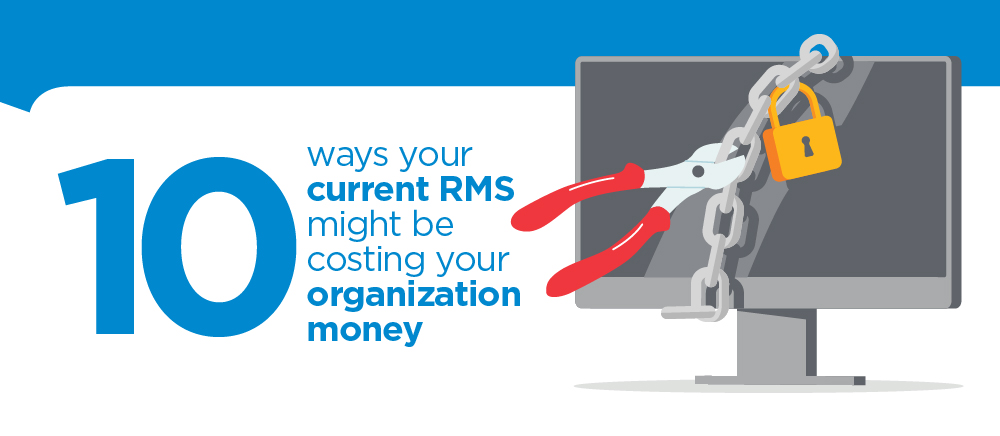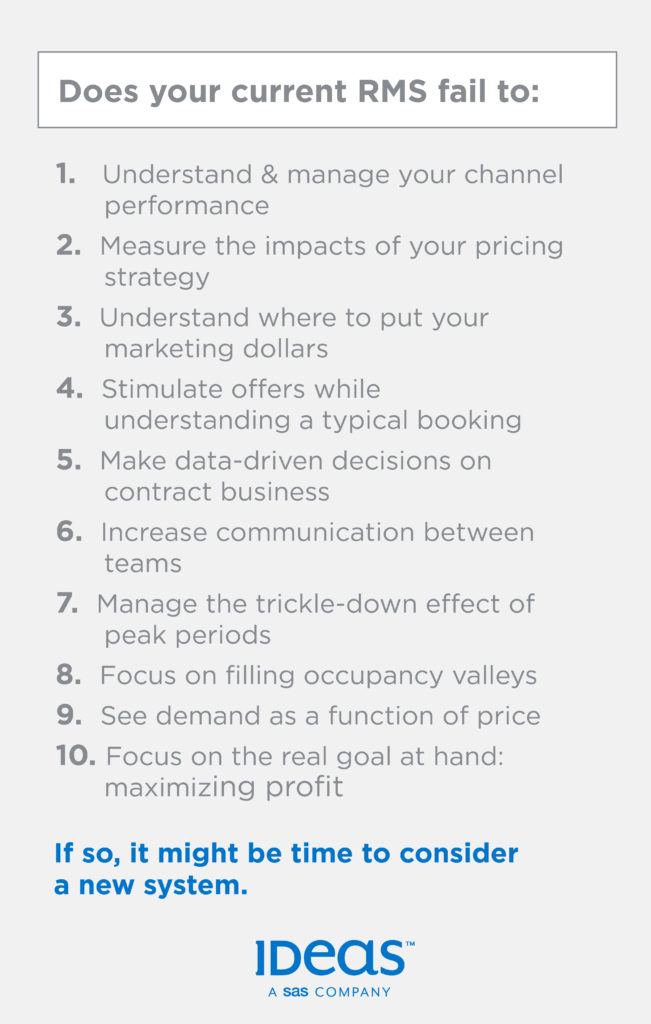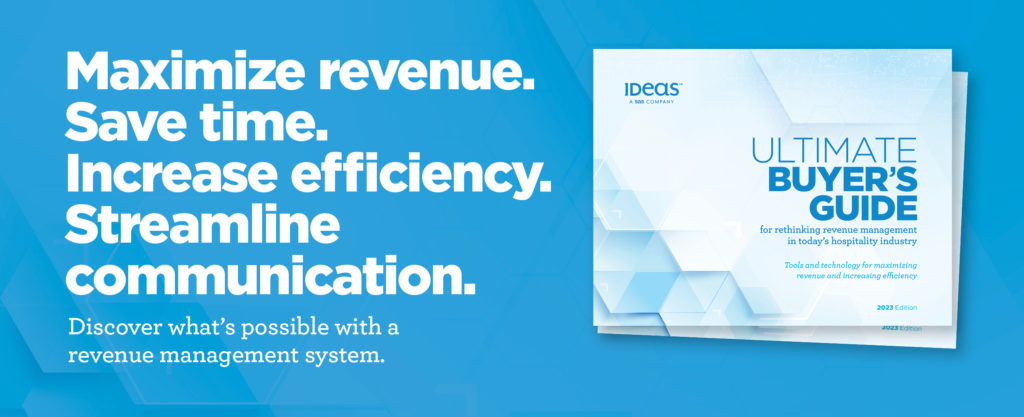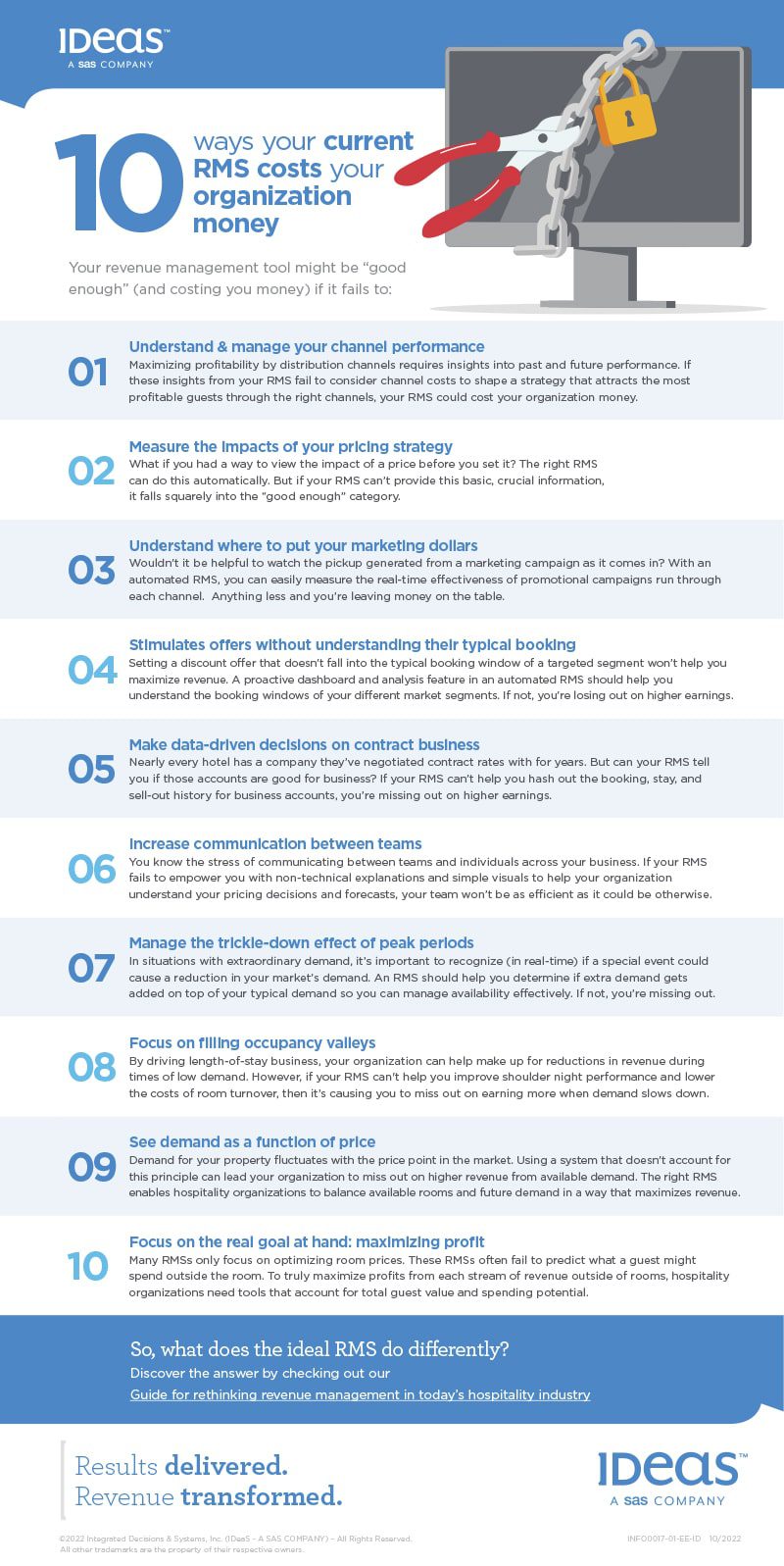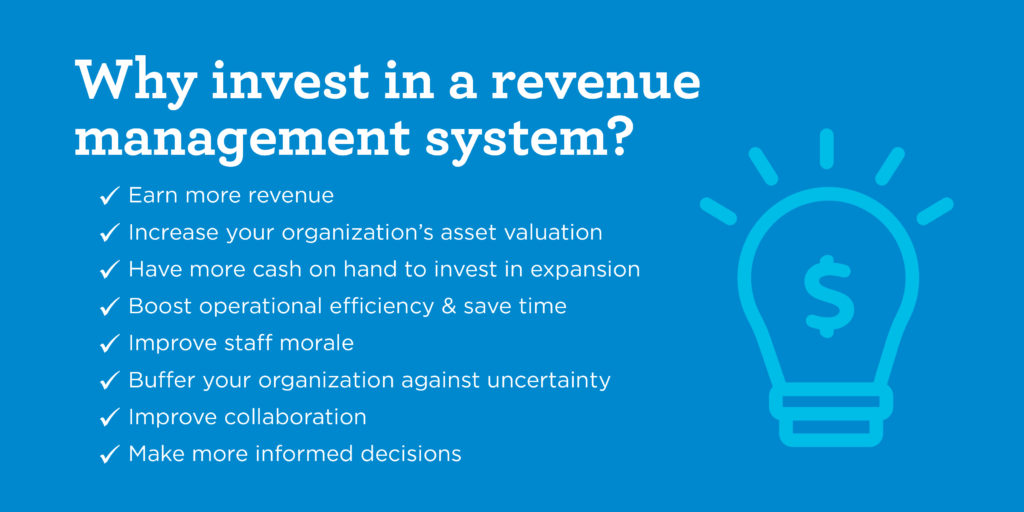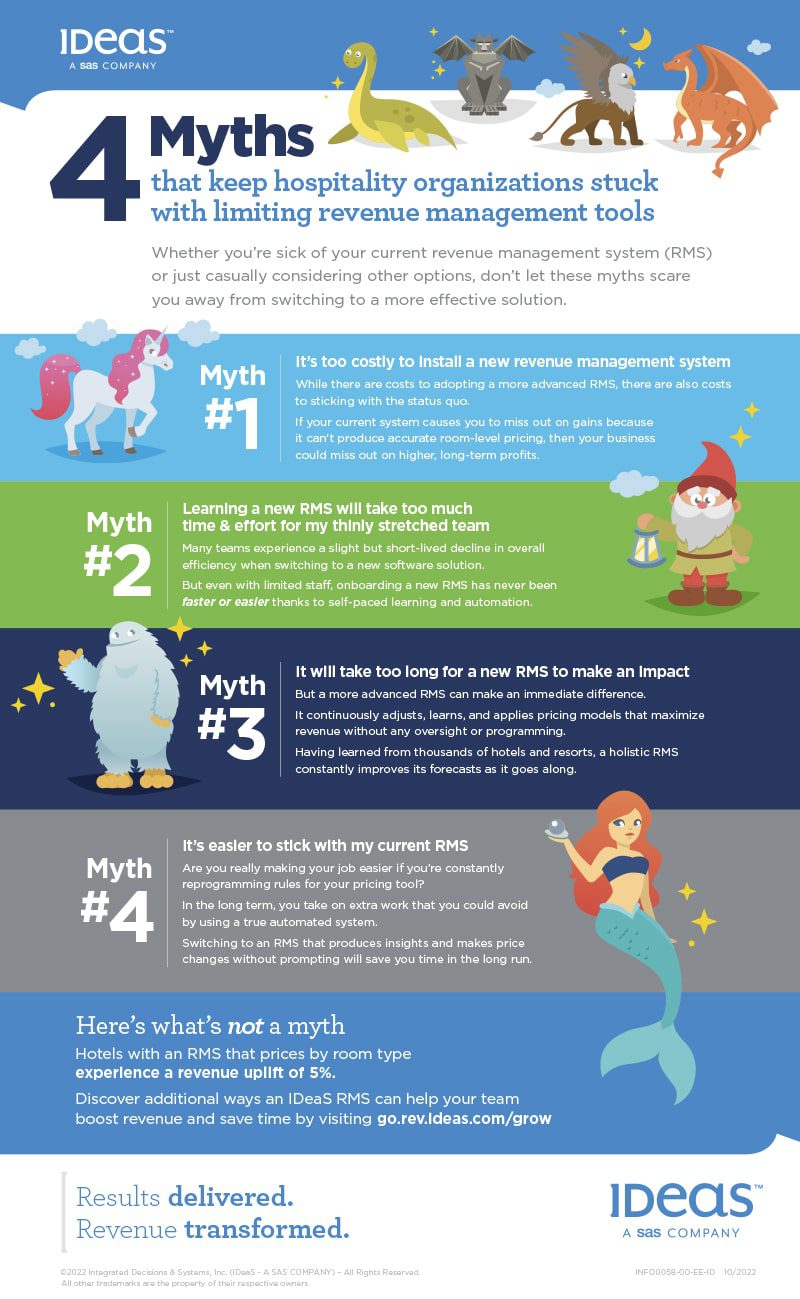When it comes to a revenue management system (RMS), many hospitality organizations settle for systems that underperform and leave money on the table.
But if you’re familiar with a particular system, you might hesitate to switch because of pervading myths around onboarding a new RMS.
And those myths—along with not knowing what other options you have—could be limiting the growth of your hospitality organization.
However, it can still feel daunting to switch to a new system. You might be wondering:
- What signs might indicate it’s time to switch to a new RMS?
- How might the current RMS cause my organization to miss out on extra revenue?
- What benefits do you get with an ideal, fully automated revenue management system?
- What myths about switching to a new RMS should I watch out for?
Don’t worry. You’re in luck.
We answer these crucial questions below.
Let’s get into it.
It might be time to switch to a new RMS if your current system fails to:
1. Understand & manage your channel performance
Maximizing profitability by distribution channels requires insights into past and future performance.
These insights should consider channel costs to shape a strategy that attracts the most profitable guests through the proper channels.
A hotelier, for example, can plan for specific channel costs by considering how effective their distribution strategy has been historically or is likely to be based on current and future circumstances.
By understanding and forecasting net channel ADR, RevPAR, revenues, and costs for all channels or specific channels, you can improve your marketing spend efficiency for each channel and find opportunities to save on commission when you know the demand is already there. That’s where the right RMS can help.
2. Measure the impacts of your pricing strategy
What if you had a way to see the impact of a price before you set it?
No, we’re not talking about a crystal ball here. We’re talking about a feature that your standard RMS should have (unless you’re cool with missing out on valuable, revenue-optimizing information).
So, ask yourself, “If I lower my rate for a particular room, could my RMS determine if the discounted offer produces enough reservations to exceed the revenue expectations of the non-discounted rates?” Your RMS should be able to provide the answer.
That might sound too good to be true, but if your RMS can’t provide this crucial information, you could be doing better.
An RMS should be able to answer a question like the above risk-free using “what-if” simulation analysis. You’re likely taking unnecessary risks with your revenue strategy if it can’t.
3. Understand where to put your marketing dollars
Wouldn’t it be helpful to watch the pickup generated from a marketing program as it comes in for a single property or the entire portfolio?
With the reporting and forecasting in an automated RMS, you can easily measure the real-time effectiveness of promotional campaigns run through each channel.
If your campaign isn’t working, your RMS will help you identify what you need to change about your promotional tactics to achieve the results you’re looking for.
What might that look like in real life?
For example, say a hotel chain runs a New Year’s promotion that discounts rooms by 20% at the end of the year.
An automated RMS—like G3 RMS from IDeaS—would allow the hotel to watch the pickup generated from that promotion as it comes in. Using their RMS, the hotel could view results for a single property, by the market, or their entire portfolio of properties (if they had multiple locations running the same promotion).
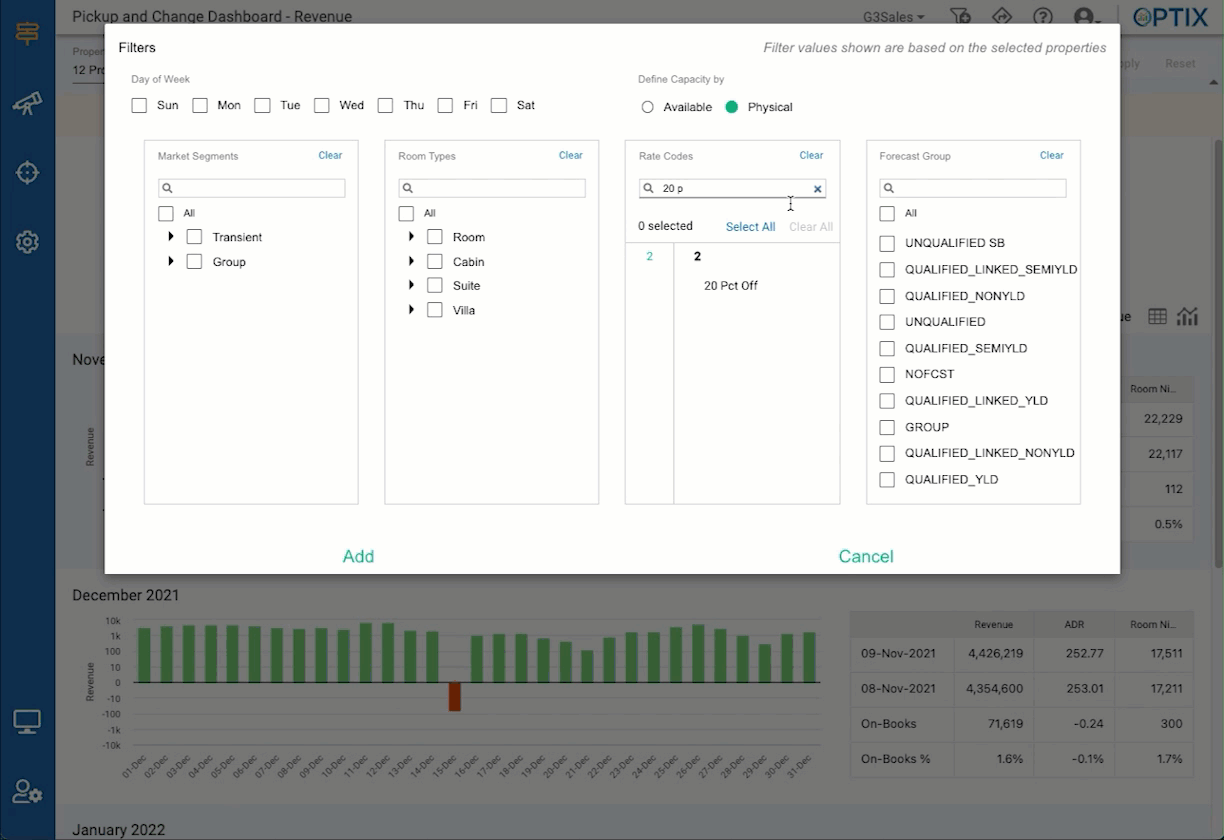
With these near real-time insights available through the dashboard of your RMS, you can measure the effectiveness of the promotion and quickly modify your promotional strategy should the need arise.
With a sophisticated, automated RMS—like G3 RMS—the hotel could also view more than promotional pickup on their RMS dashboard. The dashboard would display each day’s forecast changes at the beginning of the week, month, or year.
And that’s just the start of what G3 RMS can do.
If you’re interested in exploring more features and benefits of using G3 RMS, check out our Ultimate buyer’s guide for rethinking revenue management in today’s hospitality industry.
4. Stimulate offers while understanding a typical booking
Setting a discount offer that doesn’t fall into the typical booking window of a targeted segment won’t help you produce your desired revenue results.
This is where the proactive dashboard and analysis features in your revenue intelligence tool should help you understand the booking windows of your different market segments.
If not, you’re losing out on more significant insights and higher earnings.
5. Make data-driven decisions on contract business
Nearly every hotel has a company they’ve negotiated contract rates with for years. But can your RMS tell you if those accounts are actually good for business?
An automated revenue management system helps you hash out the booking, stay, and sell-out history for business accounts so that you can fill your calendar with only the most profitable business.
6. Increase communication between teams
You know the stress of trying to communicate between teams and individuals across your business.
Besides your general manager, the group sales team, the marketing team, and the operations team need to be on the same page to identify and capture your organization’s most profitable business opportunities.
A modern RMS should empower you with non-technical explanations and simple visuals to help your organization understand the reasoning behind your pricing decisions and forecasts.
7. Manage the trickle-down effect of peak periods
In situations with extraordinary demand, it’s important to recognize (in real-time) if a special event could cause a reduction in your market’s demand.
The right RMS can help you determine if extra demand gets added on top of your typical demand. It can then help you price and manage availability to get the greatest revenue return possible during the time of a unique event.
8. Focus on filling occupancy valleys
Revenue managers often focus on maximizing demand peaks but struggle to minimize demand valleys due to a lack of tools or know-how. It’s an ongoing challenge that most hospitality professionals experience regularly, but it can be avoided.
By driving length-of-stay business, your organization can help make up for reductions in revenue during times of low demand.
However, if your RMS can’t help you improve shoulder night performance and lower the costs of room turnover, then it’s causing you to miss out on earning more revenue when demand slows down.
9. See demand as a function of price
Demand for your property fluctuates with the price point in the market.
Using a system that doesn’t account for this principle can lead your organization to miss out on higher revenue from public demand.
A modern RMS grounded in the science of demand-based pricing enables hospitality organizations to balance available rooms and future demand in a way that maximizes revenue.
10. Focus on the real goal at hand: maximizing profit
Too often, revenue managers get told to increase room revenue through occupancy or targeted ADR goals.
But many RMSs on the market only focus on optimizing the price a guest pays for their room alone.
These RMSs often fail to go the extra distance to predict what a guest might spend outside the room in other areas, such as at a restaurant or a casino attached to the hotel.
However, there’s no guarantee that impacting these top-line metrics translates into higher flow-through to cash and profits.
To maximize profits from each revenue stream outside of rooms, hospitality organizations need tools that account for total guest value and spending potential.
Not having predictive tools like these can keep organizations from going beyond outdated goals and boosting their total hotel profitability.
So, what benefits should an RMS provide for hospitality professionals?
The ideal RMS should provide you and your organization with the following short and long-term benefits. If not, it’s time for an upgrade.
- Boost your revenue: Organizations using an automated RMS experience an increase in RevPAR by an average of 7 to 20% and a 2 to 7% lift in profit. That’s according to studies conducted by Hotel Tech Report and Deloitte, respectively.
- Higher valuation of assets: When hospitality organizations experience an increase in revenue, the overall value of the organization increases. And higher asset valuation leads to other advantages, such as broader access to capital, more favorable interest rates, and a higher chance of acquisition.
- More money for internal investments: When an organization earns more revenue because its RMS is optimizing each revenue stream, it gains even more opportunities to invest in itself. That could mean upgrading facilities, running more promotions, opening new revenue streams, or expanding to new properties. A fully automated RMS helps create the extra revenue that creates those possibilities.
- Greater efficiency & time savings: The right RMS can significantly increase the efficiency and speed of a hospitality organization. For hospitality professionals, that means more time to focus on strategy, promotion, improving the guest experience, and other revenue-generating tasks that usually get deprioritized when you’re short on time.
- Increase staff morale: Feeling equipped with the right tools and insights leads to less overwhelm and uncertainty. And that leads to higher workplace engagement. That’s what you get with a fully automated revenue management system.
- Plan ahead and maximize performance: Knowing how you’re tracking for the coming week or month and understanding the factors impacting your business can help you adjust accordingly and maximize profits.
- Improve collaboration and make better-informed decisions: An automated RMS gives hospitality professionals greater access to revenue data and empowers them with valuable insights across marketing, distribution, and operations.
Interested in a revenue management system but unsure how to pitch it to your colleagues? We have a guide to help you out.
Check out 12 Essential Steps for Pitching a Revenue Management System (RMS) to Your Colleagues to discover the step-by-step guide for getting your peers on board with an RMS.
Considering a switch? Watch out for these four myths about switching to a new RMS
Okay, so you’re considering switching to a new RMS, but you still feel unsure. That’s totally fine.
Whatever you decide, make sure you’re aware of the common myths about switching to a new system.
Myth: It costs too much to switch to a new RMS
It’s true—some costs go along with onboarding a new RMS. However, there are also costs to sticking with your current system if it isn’t providing the full value of other systems on the market.
If your current RMS causes you to miss out on extra profits or a larger share of the market because it can’t produce room-level pricing, then your business is likely better off switching to a new RMS.
And if your current RMS struggles to price and manage group business, you could also be losing out on additional profit in the long term.
So forget the myth that switching to a new RMS is too expensive. Hotels with an RMS that prices by room type (like IDeaS G3 RMS) see a revenue uplift of 5% compared to other RMSs that can’t price by room type.
Myth: Learning how to use a new RMS takes up too much time that my team doesn’t have
Indeed, teams often experience a slight decline in efficiency when they first switch to new software.
However, this decline doesn’t last long in many cases.
Even with limited staff, onboarding a new RMS has never been easier or quicker for hotels than it is today.
Self-paced learning allows employees to conduct onboarding when they have room in their schedules—even if that isn’t much room to begin with.
Plus, hotels can rely on advanced analytics and automation to handle much of the heavy lifting it takes to set up and configure a new system.
And once your system is running, productivity and efficiency accelerate.
Here’s the bottom line: When you compare your productivity while using an automated RMS to your productivity while using a rule-based pricing tool, you’ll likely experience more productivity from the automated system.
Myth: It takes too long for a new RMS to produce accurate information
When you implement a hotel revenue management system like G3 RMS, you get a system ready to make a difference immediately.
The artificial intelligence (AI) in G3 RMS allows the system to adjust and learn about your property as needed.
Plus, an RMS like G3 RMS adjusts and applies pricing models that maximize revenue for all streams without any oversight or programming. It constantly learns and improves its algorithms as it goes.
This fine-tuning ensures that the predictive forecasting feature of an automated RMS matches a property’s demand patterns so that pricing and forecasts align as market conditions change.
Myth: It’s easier to stay with the RMS I’m familiar with already
While it doesn’t require additional effort to stay with your current RMS, doing so might limit your organization’s revenue and growth.
In the long run, remaining with a rule-based RMS that needs programming and reprogramming will likely cost you more of your time than if you adopted an automated RMS earlier.
So, consider this: Do you really save time if your system requires constant reprogramming? Or would you be better off with a system that operates without supervision or rules?
As it is said, “The best time to plant a tree was 20 years ago. The second-best time is now.” Whoever said that originally wasn’t referring to an RMS, but they might as well have been. The same principle applies.
In the end, here’s what matters most
You have options when it comes to your revenue management system.
The RMS you have now doesn’t need to be the one you’re stuck with, especially if you feel it could be doing better.
To discover more of the benefits of using an automated RMS from IDeaS, head over to go.rev.ideas.com/grow.
